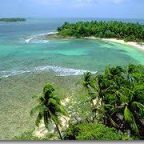
The Astrum helicopter company launches from a base less than five miles from where Belize City meets the Caribbean. In the backseat, to my left, is Belizean Senator Valerie Woods. Across from us are two representatives from international ocean protection organization Oceana, which organized the flight. The country’s minister of state, Carla Barnett, climbs into the front seat.
“I haven’t been in a helicopter for a long time,” she mutters, pulling on her headset. The doors shut, and we’re off.
As we rise above the trees, Belize City starts to spread out in front of us. But that’s not our destination. Side-skirting downtown, we head out over the water—where the true treasures lay.
The Mesoamerican Reef stretches some 700 miles from Mexico’s Yucatan Peninsula through Guatemala, to Honduras’ Bay Islands. For 184.5 miles, the reef passes through Belizean waters. Along with the lagoons and atolls on either side of the main reef, the collection is known as the “Belize Barrier Reef System.”
Heading out over the water, we almost immediately fly over a manatee reserve. The Oceana country director, Janelle Chanona, tries to point one out below, but I miss it. Crossing over the reef—a thick ribbon of turquoise—we come to the Turneffe atoll, which is one of the country’s seven marine protected areas (MPAs). In the middle of the coral-ring is a lake of darker water. Tannins from the surrounding mangrove trees cause the color, Chanona explains—though, the trees are being chopped down at a rapid rate.
In his book Coral Reefs of The World, Charles Darwin called Belize home to “the most remarkable reef in the West Indies.” As we head further out, the turquoise alternates with various shades of blue. You can see the coral and rock formations through the water. The mosaic is mesmerizing.
“The colors get me every single time,” said Chanona, staring out at the Caribbean. From the front seat, Barnett agrees. “It’s gorgeous.”
In 1996, UNESCO designated the Belize Barrier Reef Reserve System a World Heritage Site, with the former British colony responsible for protection. It’s a mandate that the country has at times struggled with. By 2009, the site was on UNESCO’s “danger” list, with the organization saying that the country needed to enact better management and safeguards. But since that low point, Belize has worked to turn things around. And ocean conservation observers say there has been impressive progress. Hence the helicopter flight, which was a victory lap of sorts.
Just this December, Belize became the first country in the world to put a moratorium on all offshore oil exploration and drilling. Oceana had arranged the helicopter to help give politicians a sense of what they had protected, and what still needs to be done. “I’m really looking forward to getting off the endangered list,” Chanona said.













Social Profiles